ASME standards for materials are a critical requirement for calculating a design’s safety factor. Materials allowable for use in various applications are covered by their relevant code.
Section II, Part D, of the ASME BPV code. Section II, D tables 1A, 1B, and 3 provide allowable stress data for use in Section 1 (Power Boilers), Section III (Nuclear), Section VIII, Division 1 (Pressure Vessels), and Section XII (Transport Tanks).
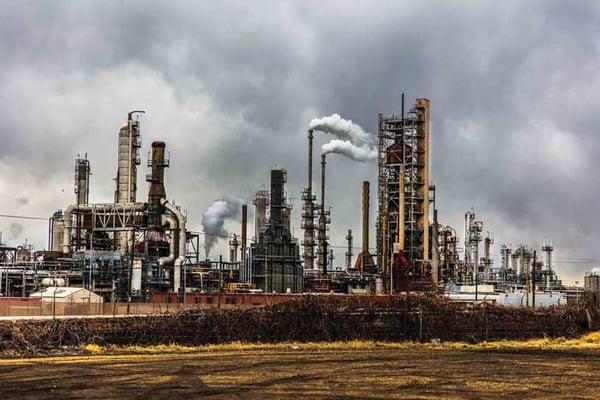
Material lines listed for use in Section VIII, Division 1; the lines that are good for Section VIII, Division 1 are explicitly marked. Table 1A covers ferrous materials, table 1B covers non-ferrous materials, and table 3 covers bolting material.
In the following, CEI provides an overview of how various material properties impact your pressure vessel design. Concentrating on 3 key aspects;
- Allowable Stress
- Additional Material Properties
- Safety Factor
Screenshots are from CEI’s DesignCalcs, pressure vessel design software. Learn more about using DesignCalcs to reduce design errors and save time on your next design.
Allowable Stress
ASME Standards Section VIII, Division 1
The allowable stresses are determined by safety factor criteria listed in the appendices in the back of the Section II, D. For the most part, this is determined by four things: the tensile strength, the yield strength, the time dependent properties at higher temperatures (creep), and the product form (bolting, plate, etc). The discussion of creep and time dependent properties is going to be left out of this article; however, if you are looking in SC II, D, and you see an allowable stress that is italicized, that is a value that is governed by creep.
For tensile strength, the code requires a safety factor of 3.5 for non-bolting and 4 or 5 for bolting. In addition, if the product form is welded tube or pipe, a joint efficiency factor of 0.85 is typically applied. This can be seen by several of the notes in the stress tables.
For yield strength, the safety factor in most cases is a ⅔ multiplier, with the joint efficiency factor of 0.85 applied in the same case as for tensile; in some cases a higher value of 90% yield may be used instead of the ⅔ value. The safety factor on yield strength for bolting material is a ⅔ multiplier or a ¼ multiplier. The lines allowing 90% of yield will include a G5 material note.
An allowable stress is determined at several temperature increments up to the allowed maximum temperature. At each of these increments, the allowable is determined based on the ultimate tensile stress, the yield stress, and the creep data. The lowest of the three governs. See Mandatory Appendices 1 and 2 in ASME BPV Section II, Part D, for more information.
ASME Standards Section VIII, Division 2
ASME BPV Section VIII, Division 2, uses a much smaller safety factor on tensile strength than Division 1 does. The safety factor is 2.4 instead of 3.5 for non-bolting (see Mandatory Appendix 10 in SC II, Part D). Note G6 in Table 5A indicates an 85% multiplier like we see for Division 1 allowables, even though the Appendix itself does not spell it out. The yield allowable criteria is the same and the bolting allowables are still from Table 3 (for design by rule).
Allowable Stress Example 1: SA-516 Gr 70 Customary for SC8D1
Allowable stress (S, psi) in 2013 is on page 22, line 6
Yield strength (Sy, psi) in 2013 is on page 578, line 30
Ultimate tensile strength (Su, psi) in 2013 is on page 488, line 8.
At 250 degrees S = min(2/3*34200 or 70000/3.5) = 20000 psi
At 650 degrees S = min(2/3*28200 or 70000/3.5) = 18800 psi
At 1000 degrees S is governed by creep data and is 2500 psi; this is less than 2/3*22600 and 69100/3.5

Allowable Stress Example 2: SA-249 TP316, High (90% yield basis) Metric for SC8D1
Allowable stress (S, MPa) in 2013 is on page 78, line 9
Yield strength (Sy, MPa) in 2013 is on page 638, line 17
Ultimate tensile strength (Su, MPa) in 2013 is on page 512, line 17.
At 150 degrees S = min(0.9*0.85*161 or 0.85*516/3.5) = 123.17 MPa, which is higher than the listed allowable of 117 MPa. The allowable at this temperature exceeds the listed SF requirements.
At 250 degrees S = min(0.9*0.85*139 or 0.85*502/3.5) = 106.34 MPa, which is very close to the listed allowable of 107 MPa.
At 375 degrees S = min(0.9*0.85*125 or 0.85*495/3.5) = 95.63 MPa, which is very close to the listed allowable of 95.7 MPa.
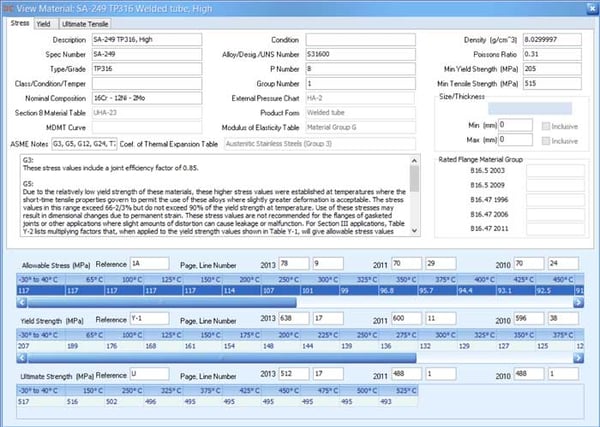
Additional Material Properties
Yield Strength
The Yield Strength primarily comes from the Y tables in Section II, Part D. DesignCalcs uses fairly strict criteria when attempting to match an allowable stress line from Tables 1A, 1B, and 3 to a yield line in the Y tables. These criteria include matching on aspects such as min yield strength, spec, and nominal composition.
Sometimes, however, a match using these criteria cannot be made. In these cases, DesignCalcs will follow the steps provided in ASME Section VIII, Division 1, UG-28(c)(2) Step 3, using the material’s listed external pressure chart. If a Y table match cannot be made and the external pressure chart method cannot be used, the yield will be listed as zero for all temperatures.
Ultimate Strength
The Ultimate Strength comes from the U tables in Section II, Part D. Similar criteria to finding a yield match are used to find an ultimate strength match for an allowable stress line.
If a match from the U-tables cannot be used, DesignCalcs employs a conservative method to find the ultimate strength values; in this case, it is assumed that the tensile strength governs the allowable stress and it is solved for in reverse order. If neither option works, the ultimate strength values will be listed as zero for all temperatures.
Other Values
The density and Poisson’s Ratio values come directly from Table PRD in SC II, Part D. All materials that are in the shipping data for DesignCalcs have both. Having a weight of zero is not a conservative assumption most of the time.
The Modulus of Elasticity (MoE) primarily comes from the TM tables in SC II, Part D, and DesignCalcs will use the criteria in these tables to assign MoE values to the allowable stress lines. However, when a clear match cannot be made, a backup method is employed. The external pressure charts (figure form as opposed to table form) include a MoE value at various temperatures. DesignCalcs will grab the MoE from the external pressure chart when it cannot find a TM table match. If neither option works, the MoE values will be zero.
The Mean Coefficient of Thermal Expansion data comes from SC II, Part D TE tables column B. There is not a backup method for this property and it is only used in a few calculations at the moment. Those calculations include calculating a sliding saddle slot length and the differential thermal expansion in a fixed tube exchanger.
Related Article: 2020 Pressure Vessel & Heat Exchanger Design Guidelines and Resources
Additional Properties Example 1:
This material will back solve for ultimate strength, if necessary, and will get its MoE values from external pressure chart CS-3 as needed.
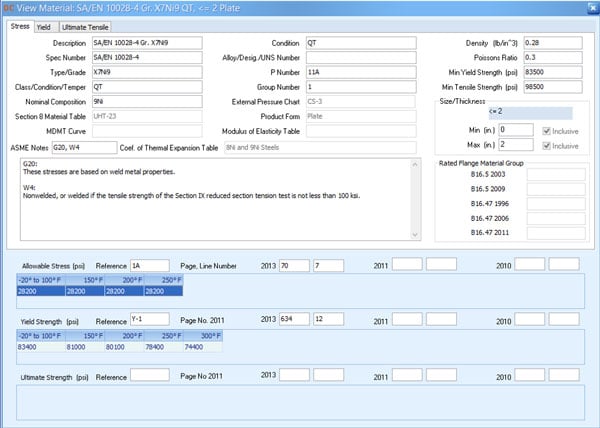
Additional Properties Example 2:
This material will back solve for ultimate strength, if necessary, and will get its MoE and Yield Strength values from external pressure chart NFA-12 as needed.
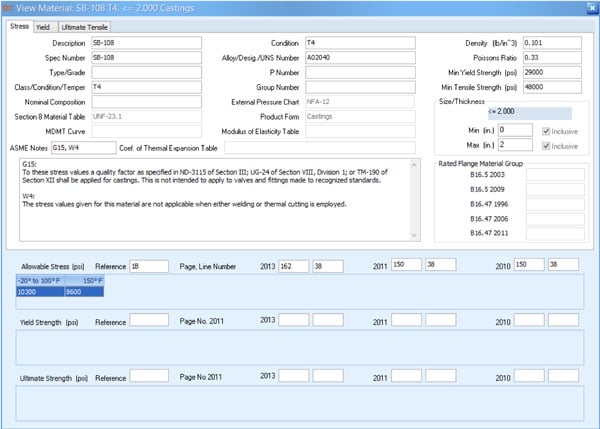
The designer still needs more flexibility. DesignCalcs provides this with custom materials and manual entry options.
Safety Factor
Previous years of ASME Standards BPV Section VIII, Division 1, used a safety factor of 4 on tensile strength instead of 3.5. Until recently, this safety factor of 4 was still in place for the design of certain DOT vessels. This discrepancy can be handled in DesignCalcs in one of several ways.
The user may set a vessel safety factor of 4 instead of 3.5. In this case the allowable stress will be calculated using 4 instead of 3.5 in equations shown in the examples above; as a safety measure, we do not allow the calculated allowable stress to be more than the allowable stress form the ASME codebook. If instead the designer wishes to use their own values for the 4:1 safety factor, or they wish to use a different safety factor on yield or whatever the criteria may be, the designer may either manually input the values in the component form for each instance or they can create a custom material.
This same approach can be used for materials that are not yet in Section II, Part D, but are included in a materials code case like Code Cases 2402-1 and 2403. It is important to remember that not all jurisdictions will accept code cases; they may also be harder to get accepted by the customer requesting the bid.
More information about custom materials may be found in our help files.

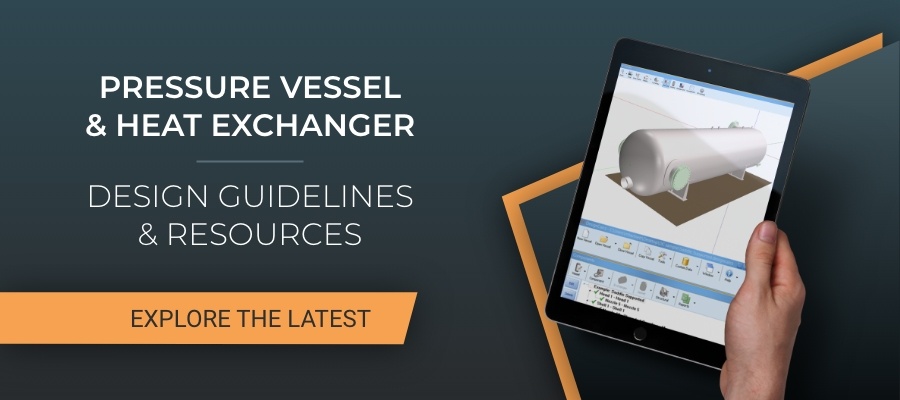


Leave a Comment